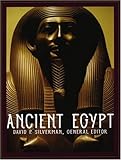Ancient Egypt

Genre: Paperback
Brand: Oxford University Press, USA
Author: David P. Silverman
Price: $24.99
The ancient Egyptians created some of the world's most beautiful art and architecture. To this day, this ancient civilization--which produced the great pyramids, the riddle of the Sphinx, and the riches of Tutankhamun--exerts a strong hold on our imaginations.
Now, in Ancient Egypt, eminent Egyptologist David P. Silverman and a team of leading scholars explore the cultural wealth of this civilization in a series of intriguing and authoritative essays based on the latest theories and discoveries. Illustrated with more than 200 superb color photographs, maps, and charts, this book illuminates the vivid and powerful symbolic images of this fascinating culture--from pyramids and temples to priests and rituals; from hieroglyphic writing to daily life by the Nile; and from temple carvings to the cult of the dead. Correcting the popular misconception of the Egyptians as a death-obsessed people, the book uses the most recent historical research and archaeological finds to illuminate the routines of daily life in royal, elite, priestly circles, as well as at lower levels of society. We learn, for example, that despite the monochromatic appearance of most temple ruins today, in ancient times they would have been colorful, even gleaming structures; that the title "Pharaoh" derives from the Egyptian phrase per aa, which means "great house" and was originally a reference to the royal palace; that temples employed all manner of part-time and full-time personnel, from farmers and carpenters to scribes, jewelers, and keepers of livestock; and that Egyptian law viewed women as equal to men, and they could, in some cases, wield considerable influence.
Now, in Ancient Egypt, eminent Egyptologist David P. Silverman and a team of leading scholars explore the cultural wealth of this civilization in a series of intriguing and authoritative essays based on the latest theories and discoveries. Illustrated with more than 200 superb color photographs, maps, and charts, this book illuminates the vivid and powerful symbolic images of this fascinating culture--from pyramids and temples to priests and rituals; from hieroglyphic writing to daily life by the Nile; and from temple carvings to the cult of the dead. Correcting the popular misconception of the Egyptians as a death-obsessed people, the book uses the most recent historical research and archaeological finds to illuminate the routines of daily life in royal, elite, priestly circles, as well as at lower levels of society. We learn, for example, that despite the monochromatic appearance of most temple ruins today, in ancient times they would have been colorful, even gleaming structures; that the title "Pharaoh" derives from the Egyptian phrase per aa, which means "great house" and was originally a reference to the royal palace; that temples employed all manner of part-time and full-time personnel, from farmers and carpenters to scribes, jewelers, and keepers of livestock; and that Egyptian law viewed women as equal to men, and they could, in some cases, wield considerable influence.